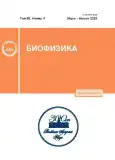Effect of α1-adrenoreceptors stimulation on electrical activity of rat atria
- Авторлар: Mansour N.1, Ziyatdinova N.I1, Gallieva A.M1, Shakirov R.R1, Zefirov T.L1
-
Мекемелер:
- Kazan Federal University
- Шығарылым: Том 68, № 4 (2023)
- Беттер: 748-753
- Бөлім: Articles
- URL: https://journals.rcsi.science/0006-3029/article/view/142129
- DOI: https://doi.org/10.31857/S0006302923040154
- EDN: https://elibrary.ru/KMWXBE
- ID: 142129
Дәйексөз келтіру
Толық мәтін
Аннотация
Негізгі сөздер
Авторлар туралы
N. Mansour
Kazan Federal University
Email: nourm94@mail.ru
Kazan, Russia
N. Ziyatdinova
Kazan Federal UniversityKazan, Russia
A. Gallieva
Kazan Federal UniversityKazan, Russia
R. Shakirov
Kazan Federal UniversityKazan, Russia
T. Zefirov
Kazan Federal UniversityKazan, Russia
Әдебиет тізімі
- R. M. Graham, Cleve Clin. J. Med., 57 (5), 481(1990).
- D. M. Perez, Front. Pharmacol., 29, 11 (2020).
- R. P. Ahlquist, Am. J. Physiol., 153 (3), 586 (1948).
- A. L. Morrow and I. Creese, Mol. Pharmacol., 29 (4), 321 (1986).
- D. M. Perez, M. T. Piascik, and R. M. Graham, Mol. Pharmacol., 40 (6),876 (1991).
- J. R. Docherty, Eur. J. Pharmacol., 855, 305 (2019).
- A. J. Baker, Pflugers Arch., 466 (6), 1139 (2014).
- T. L. Zefirov, et al., Uchenye Zapiski Kazanskogo Universiteta. Seriya Estestvennye Nauki, 160 (4), 613 (2018).
- S. Z. Langer, Biochem. Pharmacol., 23 (13),1793 (1974).
- K. B. Lai, J. E. Sanderson, and C. M. Yu, Cardiovasc. Drugs Ther., 23 (4), 271 (2009).
- T. D. O'Connell, B. C. Jensen, A. J. Baker, and P. C. Simpson, Pharmacol. Rev., 66 (1), 308 (2014).
- K. Nishimaru, M. Kobayashi, T. Matsuda, et al., AJP Heart Circ. Physiol., 280 (1), H132 (2001).
- M. Stengl, K. Mubagwa, E. Carmeliet, and W. Flameng, Cardiovasc. Res., 38 (3), 703 (1998).
- G. Gambassi, H. A. Spurgeon, E. G. Lakatta, et al., Circ. Res., 71(2), 870 (1992).
- A. S. Averin, L. A. Andreeva, S. S. Popova, et al., J.Comp. Physiol. B, 191, 927 (2021).
- S. H. Woo and C. O. Lee, Pflugers Arch., 437 (3), 335 (1999).
- T. L. Zefirov, I. I. Khabibrakhmanov, N. I. Ziyatdinova, and A. L. Zefirov, Bul. Exp. Biol. Med., 162 (1), 4 (2016).
- S. Zhang, R. Takahashi, N. Yamashita, et al., Eur. J. Pharmacol., 839, 82 (2018).
- J. M. Nerbonne and R. S. Kass, Physiol. Rev., 85 (4), 1205 (2005).
- S. A. Kodirov, V. L. Zhuravlev, T. A. Safonova, et al., Rev. Clin. Pharmacol. Drug Therapy, 3 (4), 27 (2004) [in Russian].
- L. Virag, N. lost, M. Opincariu, et al., Cardiovasc. Res., 49 (4), 790 (2001).
- E. Grandi, M. C. Sanguinetti, D. C. Bartos, et al., J. Physiol., 595 (7), 2209 (2017).
- I. I. Khabibrakhmanov, N. I. Ziyatdinova, and T. L. Zefirov, Russ. J. Cardiol., 26 (5), 53 (2021).
Қосымша файлдар









